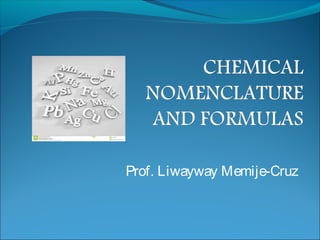
Chemical nomenclature and formulas
- 2. Introduction Chemistry is involved with various and diverse interactions of matter either around us or simply inside the laboratory. These are described using the language of chemistry which consists of symbols, formulas and equations.
- 3. Chemical Symbols shorthand abbreviations for elements composed of a single capital letter or a capital letter and one or two small letters.
- 4. Chemical Formula indicates the relative number of atoms of each element in a substance. It consists of symbols of elements and subscripts which give the number of atoms of each element.
- 5. In writing formulas, the total positive charges plus the total negative charges must equal to zero since the compound is electrically neutral.
- 6. Cations, anions, radical or polyatomic ions
- 7. Rules in writing formulas of compounds There are basic rules in writing formulas of compounds. These are: Write first the symbol of the positive ion followed by the symbol of the negative ion or radical. A radical or polyatomic ion is a group of atoms which acts as a single atom. Criss-cross: the valence of the positive ion becomes the subscript of the negative ion, while the valence of the negative ion becomes the subscript of the positive ion. (You have to disregard the sign)Example: Al+3 O-2 = Al2O3 If the valence is numerically equal, there is no need to criss -cross since the sum of the valence is zero.Example: Ca+2 O-2 = CaO Do not write the subscript if it is only 1. If the subscript of the radical is greater than 1, the radical is enclosed with a parenthesis. Example:Mg-2 PO-3 = Mg3 (PO2)2 Subscripts should be reduced to the lowest ratio.Example: Sn+4 O-2 = Sn2 O4 = SnO2
- 8. How Are Compounds Named These are compounds of weakly bonded H atoms. In solution, they release ions. A given nonmetal may form a series of acids.
- 9. Common Acids
- 10. Bases identified by the presence of the hydroxide group (OH). Name of the metallic portion first followed by the word hydroxide. Examples: NaOH - Sodium Hydroxide Fe(OH)2 - Iron(II) Hydroxide or Ferrous Hydroxide Fe(OH)3 - Iron(III) Hydroxide or Ferric Hydroxide
- 11. Salts Salts are formed when metallic atoms replace the weakly bonded hydrogen atoms of an acid. They are named after the acid from which they are formed. The name of the metal comes first, followed by the name of the nonmetallic group. The ending ‘ic’ is changed to ‘ate’ and the ending ‘ous’ to ‘ite’. For salts with no oxygen atom, the prefix ‘hydro’ is dropped and ending ‘ic’ is changed to ‘ide’. For example, the acid HNO3 (nitric acid) forms the salt KNO3 (potassium nitrate), when the metallic atom K places H atom of the acid. As another example, the acid HNO2 (nitrous acid) forms the salt KNO potassium nitrate). The ending ‘ous’ of the acid is changed to ‘ite’. HI (hydroiodic acid) forms the salt KI (potassium iodide). Since there is no more hydrogen atom in the salt, the prefix “hydro” of the acid name is dropped. The ending ‘ic’ of the acid is changed to “ide’ in salt.
- 12. Oxides are compounds of oxygen with metals or nonmetals. Name the metal or the nonmetal first. Then use the prefixes di, tri, tetra or penta before the term oxide to indicate the number of oxygen atoms present. In case where the number of oxygen atom present can determine from oxidation number of the combined metal, the prefix is omitted. Examples: 1.NO2: Nitrogen Dioxide 2.N2O4: Dinitrogen Tetroxide 3.P2O5: Phosphorus Pentoxide 4.PbO: Lead(II) oxide or Plumbous Oxide 5.PbO2: Lead(IV) oxide or Plumbous Oxide
- 13. Questions for Study and Review I. Name the following compounds by identifying the oxidation number of the metal as you name the compounds listed below: 1. KCl 2. PbS 3. CrSO4 4. Fe(NO3)2 5. Sn(ClO4)3 II. Formula Writing: Write the correct chemical formula of the following: 1. Calcium carbonate 2. Magnesium hydroxide 3. Copper sulfate 4. Carbon tetrachloride 5. Potassium bromate 6. Ammonium hydroxide 7. Lead nitrate 8. Sulfuric acid 9. Nitric acid 10.Boric acid
